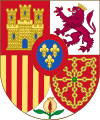Ballestero de monte
The Ballestero de Monte (mountain crossbowman) or Fiel de rastro (marksman of the trail), was a member of a body which provided vigilance in the mountains of Murcia, Lorca, Cartagena and Orihuela as well pursuing bandits from the Kingdom of Granada when they attacked. These groups operated between the 13th and 15th centuries.
Functions
Monitoring the mountains
Their primary function was to patrol the communal grassland and mountainous areas of the Kingdom of Murcia. These patrols were designed to control illegal logging, grain harvesting, fires and charcoal production. They were prohibited from engaging in these activities as well as preventing others from doing them. They faced penalties if they failed, resulting in damage being done to the lands of Cartagena.[1]
Requirements
Membership in this group required three basic criteria: good physical condition; knowledge of the terrain; and tracking skill. On 24 January 1385, their efficiency led King Juan I of Castile, upon request from the Council of Murcia, to stipulate that they were to be exempted from paying taxes. His declaration stated, in part, "Since in that land there are men who know how to follow the trails of those from the land of the Moors who enter to hurt and damage our kings were it not for the mountain crossbowman...we have by good and it is to our favour that there are in that location, six mountain crossbowmen, to follow the said trails and that they be relieved of money for ever."[4]
Because of the dangerous working conditions and high physical demands, the active life of ballesteros was short, due to either retirement or premature death. Therefore, a system of generational rotation was employed to ensure new young men could be trained and substituted for the older veterans in a timely fashion.[5]
Levels
Each group had a leader, chosen democratically by its members, and potentially had several levels. Men were grouped by their skill, with the lowest being "el mancebo" (the youth), who was being apprenticed to learn the trade. The levels were as follows:[6]
- Old mountain crossbowman
- Young mountain crossbowman
- Youth
See also
- Almogavar
- Border of Granada
- Kingdom of Murcia
- Reconquista
- Granada War
References
- Torres Fontes, Juan (1988). Murcia Medieval.
- Garcia Anton, J. (1987). Cautiverios, canjes y rescates en la frontera entre Lorca y Vera en los últimos tiempos nazaríes. Volume I. Murcia. pp. 547–559.
- Torres Fontes, Juan (1980). "Notas sobre fieles de rastro y alfaqueques murcianos". Murgetana (57): 71–116.
- Torres Fontes, Juan (1988). Murcia Medieval. p. 103.
- Torres Fontes, Juan (1988). Murcia Medieval. p. 104.
- Rocafort, Guillermo. Enigmas y misterios de los almogávares. pp. 111–112.
